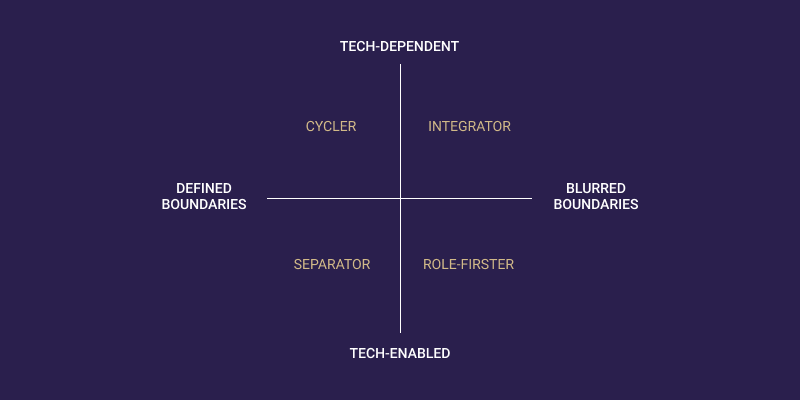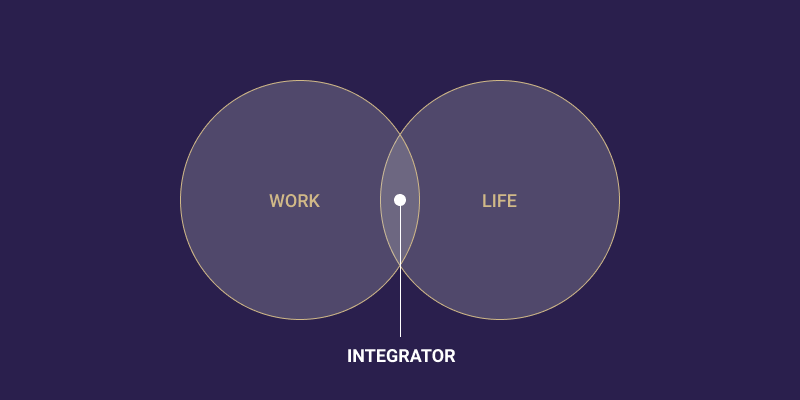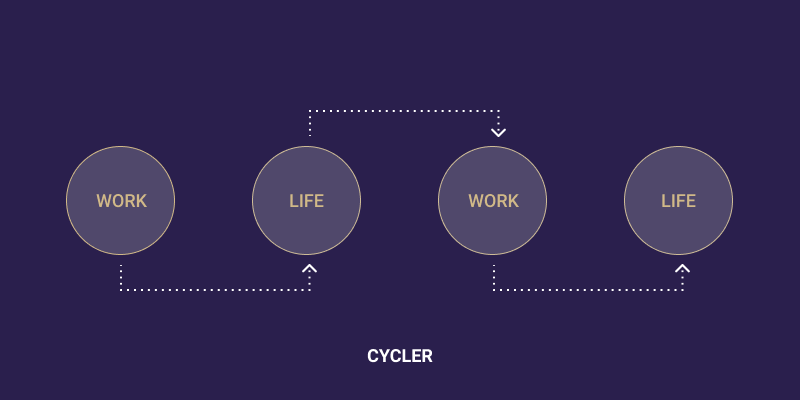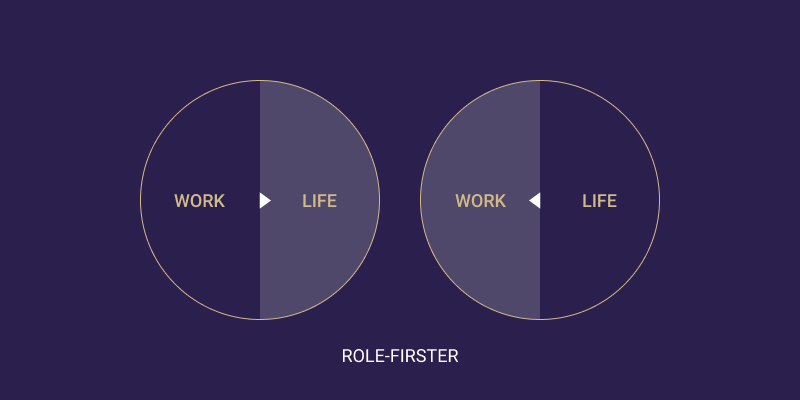Remote Boundary Management Styles
Four methods for creating your optimal work-life balance
Eighteen inches — that’s the distance between my “office” and my couch.
Finding work-life balance is uncharacteristically difficult when there isn’t a natural physical distance between work and life. But boundary management is no longer optional.
Work and life are magnetic — they’re attracted and repelled by movement. And right now, our world is experiencing a strong attraction.
Whether you’re an individual contributor, teammate, or manager, effectively managing your personal and professional interactions is key to maintaining optimal productivity and happiness. But there are multiple ways to get at this challenge.
When you use a screen to connect, where do you go to disconnect? What happens when your sense of space is permanently invaded by the digital signal? Remote work and remote life are forever commingled.
People are tied to their computers and phones. Screens have ruled our lives for years, but when you switch to remote work, the screen becomes your life. Remote isn’t just a different way of working, it’s a different way of living. And if you’re not careful, the only thing you’ll experience is work.
But there’s still hope. For those who want to take work-life balance into your own hands, the first step is admitting there’s a problem. The second step is understanding the four types of boundary management:
Integrators
Cyclers
Separators
Role-Firsters
Before we dive into each of the styles, let’s take a step back to understand why boundary management matters and why the rules are slowly breaking.
Why Are Work-Life Boundaries Important?
When it comes to work-life balance, remote workers are struggling to create physical—and psychological—boundaries. The rapid acceleration into remote work that COVID-19 brought on has quickly blurred the line between work and life. The increased interruptions and distractions associated with working from home decrease our productivity and force us to feel as if we’re behind the eight ball. With each passing day, we work longer hours to simply “catch up.”
We’re overworking due to over accessibility, not an increased workload. A few data points to consider:
A study by National statistics in the US surfaced a recent increase in work-life stress and the need to find strategies to manage our new normal.
Furthermore, a Families and Work Institute study reports that 75% of working parents do not have enough time for their children or each other.
Despite being more connected, a study by the IBM Institute for Business Value found that millennials value drawing a line between work and non-work to better enjoy a life outside the office.
As employees find it increasingly difficult to manage their work-life balance, it’s easy to resort to an oversimplification: just create better boundaries. However, anyone who’s telecommuted or worked as a remote employee knows that it is, in fact, not that simple.
Boundary Composition
“Find a job you enjoy doing, and you will never have to work a day in your life.”
We hear you, Mark, but sometimes it’s hard to tell the difference.
I’ve always loved my work and have found myself deeply absorbed, often to the point of exhaustion. For me, it’s never been a question of wanting to work. It’s been a question of whether I’m making time for anything else. Turning off email or leaving the office rarely meant I was “off.” Furthermore, I realized that physical barriers were not as critical as psychological barriers.
Every person will prioritize their barriers differently. For some, the office provides the perfect physical location and barrier, simultaneously creating distance without limiting collaboration. For others, the physical office can be stifling and restrictive, creating emotional and psychological tension. Whatever your style, there are three primary elements that make up each boundary management style:
Physical Boundaries
Physical boundaries are what we’re most accustomed to — the walk to the office; the commute home; the midday break at the coffee house; the journey to the bathroom. Working from home quickly reminds us of the value the office provided: an escape. If, like me, your desk is situated next to your living room, it’s difficult to create the space needed to detach. But physical separation can also be architected by turning off your email or creating out of office reminders. The goal is to use physical and digital environments to create separation.
Psychological Boundaries
Unplugging can be one of the biggest challenges for remote workers. Even with impeccable physical barriers, the anxiety of disconnecting can outweigh our ability to feel effectively separated from work. Whether you just need time for a mental breather, quality time with friends, family, or a partner, or just space to relax — it can feel impossible.
Emotional Boundaries
Last, but certainly not least, is the emotional safety needed to experience your emotions. The office is meant to feel cold, calculated, and logical. But life simply doesn’t comply with those rationalist constraints. As work and life find themselves indefinitely intertwined, our emotions are irrevocably connected to our work environment. Maybe it’s the feeling of missing an important moment with your child or just having a difficult interaction with a coworker, emotional boundaries are a necessity for maintaining productivity and well-being in the workplace.
Boundary Management Styles
Boundary management styles are like personalities — everyone has one and they’re all a bit different. Some of us like more physical separation, while others need more protective psychological barriers. No matter your preference, boundary control is deeply important and personal. It helps you manage the space between non-work and work.
InVision—a company I previously worked with—used to call this space between non-work and work “work-life integration.” Personally, I never liked this phrase. For me, it assumes that we should integrate our work and our life. More pedantically, it places work first — sorry, but sometimes order matters.
While that style worked for InVision, it didn’t work for me. Initially, I found this disheartening, that is, until I discovered the four boundary management styles articulated in a recent paper from Kossek, E.E. In the article, they outline the strategies that I’ve attempted to employ, with varying degrees of success as a remote employee and leader.
Integrators
Integrators are the people most responsible for the always-on culture. They seek to constantly combine work and non-work activities. They’re comfortable with ongoing interruptions and draw little distinction between work and non-work time.
Cyclers
Unlike Integrators, Cyclers need periods of separation. Instead of blending work and non-work activities, they use time-blocking to temporarily separate their time. Cyclers tend to have varying patterns of boundary interruption styles, sometimes experiencing deep integration or strong separation.
Separators
Separators are the most restrictive, keeping work and non-work activities completely separate. They rarely allow interruptions and focus on time-blocking strategies to create the physical and psychological space they need.
Role-Firsters
As an extension of the Separators, Role-Firsters define a dominant priority and prioritize their time based on that priority.
Life-First. Life-firsters experience the reverse, accepting non-work interruptions during work, and experience few interruptions during non-work hours.
Work-First. Work-firsters tend to accept a significant amount of work-related communication during non-work hours but accept few non-work interruptions during work hours.
These styles deeply impact how we adjust to remote work, particularly as it pertains to the psychological experience. For example, separators typically allow few interruptions when they’re either in work or non-work modes. By contrast, Integrators consistently engage in and encourage interruptive behaviors throughout the day, creating an always-on perception.
How to Find Your Style
The more remote the work, the more important your boundary management style becomes. Employers can only help so much, so ultimately, it’s on you to find your style.
Check your stats. Take stock of the key metrics that matter. Is it important that you spend time putting your kids to bed at the end of the day? Are you most productive and satisfied when you’re working late at night? If so, does this jive with your partner or family?
Test multiple strategies. Our natural tendencies don’t always provide the right solution for our needs. Don’t be afraid to try new strategies. If you’re a natural Integrator, you may find that switching to Separator actually helps you achieve your ideal work-life balance.
Combine and create. These styles aren’t a perfect match, so don’t be afraid to combine and create new versions. Maybe you like separation during the summer and integration throughout the school year. Iterate and find what works for you.
As work and life meld together, it should be clear that creating physical, psychological, and emotional boundaries is critical for remote employees and employers. These boundaries not only impact our attention, productivity, and well-being, but also our relationships with our families, partners, and teammates. Employers and employees need to start developing competencies in work-life balance management to foster a better work environment for the future.




